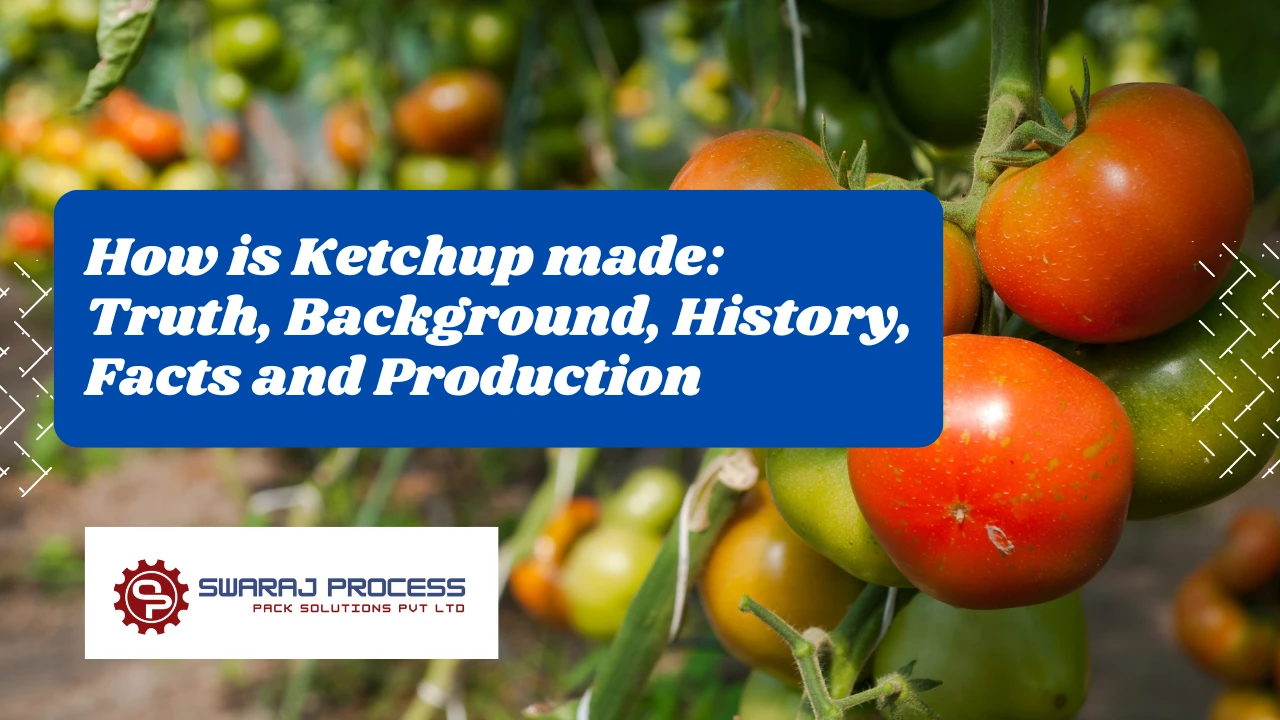Ketchup’s tangy, sweet, and slightly spicy taste is one of the most loved around the world that perfectly complements everything from fries and burgers to sandwiches and snacks. But have you ever wondered how ketchup is made, or where this globally popular sauce actually came from? Let’s take a deep dive into the truth, background, history, facts, and production process of ketchup — and understand how companies like Swaraj Process Pack, a leading tomato processing plant manufacturer in India, play a vital role in bringing it to your table.
The Background & History of Ketchup
The origin of ketchup is quite fascinating — it didn’t start with tomatoes at all! The word “ketchup” is believed to come from the Chinese word “ke-tsiap,” which referred to a fermented fish sauce popular in the 17th century. Traders brought this sauce to Europe, where it gradually evolved as people experimented with different ingredients.
By the early 1800s, tomatoes became the star ingredient, especially in America. Early ketchup recipes used tomatoes, vinegar, sugar, and spices — creating the base for the version we love today. Over time, ketchup transformed from a homemade condiment into a mass-produced product available across the world.
The Truth About Ketchup Production Today
Modern ketchup production is a combination of food science, automation, and strict quality control. Today’s ketchup factories are highly mechanized, ensuring consistency in flavor, texture, and safety.
How Ketchup Is Made: The Production Process
Modern ketchup manufacturing involves advanced machinery and strict quality control to ensure consistency, flavor, and safety. Swaraj Process Pack, a reputed tomato processing plant manufacturer, supplies high-efficiency equipment that streamlines every stage of ketchup production. We ensure quality and hygiene standards are maintained.
Here’s a simplified overview of the ketchup production process:
1. Selection of Fresh Tomatoes
The ketchup-making journey begins with the selection of high-quality tomatoes. Only ripe, red, and juicy tomatoes are chosen, as they contain the perfect balance of flavor, color, and natural sugars.
Unripe or damaged tomatoes are rejected through manual or machine sorting to ensure consistency in the final product.
2. Washing and Sorting
The selected tomatoes are then washed thoroughly to remove soil, pesticides, and any foreign particles.
In industrial plants, bubble washers and spray cleaning systems are used for deep cleaning.
After washing, automatic sorting machines remove spoiled tomatoes to ensure only the best are processed.
3. Crushing and Pulping
Clean tomatoes are crushed and pulped using specialized tomato pulping machines. This process separates the pulp from the seeds and peels, producing a smooth and rich tomato puree.
The pulp forms the base ingredient for ketchup and other tomato-based products.
4. Preheating and Concentration
The tomato pulp is heated to deactivate enzymes and destroy bacteria, ensuring longer shelf life.
Then, it’s passed through vacuum evaporators, which remove excess water and convert the pulp into a concentrated tomato paste.
This paste is the heart of ketchup — thick, rich, and full of natural tomato flavor.
5. Mixing and Formulation
The concentrated paste is transferred to large mixing kettles where other key ingredients are added:
- Vinegar – for acidity and preservation
- Sugar or corn syrup – for sweetness
- Salt – for taste
- Spices and herbs – such as onion powder, garlic, cloves, cinnamon, and pepper
- Preservatives and stabilizers – to maintain freshness and texture
The perfect balance of these ingredients defines the ketchup’s signature sweet-tangy flavor.
6. Cooking and Blending
The mixture is cooked at controlled temperatures in steam-jacketed kettles. Continuous stirring ensures even cooking and prevents burning.
After cooking, the ketchup is homogenized — a mechanical process that gives it a smooth, lump-free texture.
7. Filtration and Quality Control
Next, the ketchup passes through filters to remove any remaining solids.
Quality control tests are carried out for:
- Viscosity (thickness)
- pH level (acidity)
- Color and consistency
- Taste and aroma
- Microbial safety
Only ketchup that meets strict standards proceeds to the next step.
8. Bottling and Packaging
The hot, sterilized ketchup is filled into glass bottles, plastic containers, or pouches using automatic filling and sealing machines.
The bottles are sealed immediately to prevent contamination, cooled, labeled, and packed for distribution.
9. Storage and Distribution
Finally, the packed ketchup is stored in temperature-controlled warehouses before being shipped to stores, restaurants, and export destinations.
Interesting Facts About Ketchup:
- The first commercial tomato ketchup was introduced by Heinz in 1876.
- Ketchup was once marketed as a medicine in the 1830s, believed to cure indigestion.
- Natural lycopene in tomatoes gives ketchup its rich red color and health benefits.
- The slow pour of ketchup from a glass bottle (the “57 trick”) is a Heinz trademark phenomenon.
- Natural tomato ketchup contains lycopene, an antioxidant known to reduce the risk of certain diseases.
- It takes around 6 kilograms of tomatoes to produce 1 kilogram of ketchup.
- Modern ketchup factories can process up to 10 tons of tomatoes per hour using advanced automated plants.
Swaraj Process Pack – Leading Tomato Ketchup Plant Manufacturer
Swaraj Process Pack is a leading tomato processing plant manufacturer in India, specializing in manufacturing machinery for ketchup, tomato puree, and sauce production over all full tomato processing lines. Their advanced processing systems are designed for maximum yield, hygiene, and energy efficiency, making them a preferred partner for food processing industries. Our product range:
- Tomato Ketchup & Sauce Plants
- Tomato Puree & Paste Production Lines
- Fruit Pulper & Concentration Systems
- Aseptic Filling and Packaging Units
With advanced technology and decades of expertise, Swaraj supports food manufacturers in delivering top-quality ketchup and tomato processing plants to global markets.
Conclusion:
From ancient fish sauce origins to the iconic tomato ketchup we know today, the journey of this condiment is as rich as its flavor. With the Swaraj tomato processing line, the production process combines modern technology, strict quality standards, and precise ingredient blending to create that perfect balance of sweetness and tang.
With the help of these efficient machines the ketchup manufacturing process has become more efficient, sustainable, and consistent — ensuring that every drop of ketchup you enjoy meets the highest standards of taste and quality.





